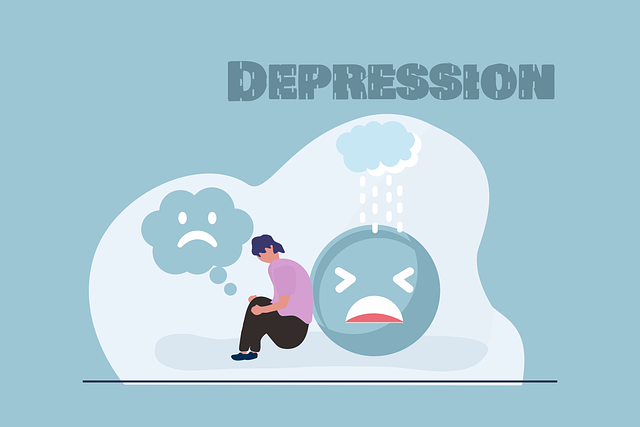Mental health professionals working with children require a nuanced approach to risk management, addressing unique challenges such as non-verbal communication and emotional regulation. They must create safe spaces that promote emotional healing, conflict resolution, and mood management techniques, integrating evidence-based pediatric practices. Proactive vulnerability assessments, specialized trauma therapy, self-care practices, boundary setting, and resilience building are crucial for both practitioner well-being and client outcomes, including pain management. Regular reviews, policy creation, staff training, and safety protocols ensure dynamic risk management aligned with best practices and legal requirements, enhancing care quality. Community outreach programs expand access to support services, fostering long-term resilience in therapy clients focusing on pain management. Continuous monitoring, review, and improvement of treatment outcomes tailor interventions for individual circumstances, keeping professionals informed about emerging research in child therapy and promoting emotional intelligence within organizations.
Mental health professionals play a crucial role in helping children navigate emotional challenges. However, managing risks associated with their practice is essential for delivering safe and effective therapy. This article guides mental health experts through the process of creating a robust risk management plan. We explore understanding and mitigating risks specific to child therapy, identifying hazards, developing strategies for secure environments, continuous monitoring, and improvements. By implementing these steps, professionals can enhance patient safety while fostering positive outcomes in pain management.
- Understanding Risk in Mental Health Practice with Children
- Identifying Potential Hazards and Vulnerabilities
- Developing a Comprehensive Risk Management Plan
- Implementing Strategies for Safe Therapy Environments
- Continuous Monitoring, Review, and Improvement
Understanding Risk in Mental Health Practice with Children

Mental health professionals working with children must possess a nuanced understanding of risk, as it manifests in unique and complex ways within this population. Unlike adults who may present more straightforward challenges, children often struggle to communicate their emotions and experiences verbally. This can make it harder to identify potential risks and triggers for mental health issues. For instance, a child’s behavior might be a form of non-verbal communication indicating underlying distress or trauma.
Risk management in therapy for children goes beyond simply ensuring physical safety. It involves creating a therapeutic environment that supports emotional regulation, conflict resolution techniques, and effective mood management strategies. Professionals must be adept at recognizing subtle cues and understanding the context within which these behaviors occur. By integrating evidence-based practices tailored to pediatric needs, therapists can effectively mitigate risks and foster healthy development, ultimately enabling children to build resilience and navigate their emotions in constructive ways.
Identifying Potential Hazards and Vulnerabilities

Mental health professionals often find themselves navigating complex emotional landscapes, both within their practice and in their personal lives. Identifying potential hazards and vulnerabilities is a critical step in risk management planning. By proactively assessing these areas, therapists can mitigate challenges that may impact their well-being and effectiveness. One significant aspect to consider is the management of trauma, especially when working with children who have experienced adverse events. Effective therapy for children requires specialized skills and a safe environment to facilitate emotional healing processes.
Professionals must also be mindful of personal boundaries and self-care practices. Regular Self-Awareness Exercises can help therapists maintain perspective and prevent burnout. Building resilience is an essential component of this process, as it equips professionals with the tools to navigate challenging situations while prioritizing their mental health. This proactive approach ensures that practitioners are better equipped to provide quality care, enhancing not only their own well-being but also the outcomes for the clients they serve, including those needing pain management strategies.
Developing a Comprehensive Risk Management Plan

In the realm of mental health profession, managing risks effectively is paramount to ensuring both patient well-being and practitioner sustainability. Developing a comprehensive risk management plan involves a systematic approach that incorporates various strategies tailored to specific practice areas, such as therapy for children and pain management. This plan should encompass policy creation, staff training on risk assessment and mitigation techniques, and the implementation of robust safety protocols. By integrating confidence-boosting measures and self-esteem improvement initiatives, mental health professionals can mitigate burnout prevention risks while enhancing their ability to provide quality care.
A key component of this process is regular review and updating of the risk management plan based on evolving best practices, legal requirements, and emerging challenges. This dynamic approach ensures that practitioners remain equipped to navigate complex situations with confidence, fostering a supportive environment for both clients and practitioners alike. Effective risk management not only safeguards against potential harm but also empowers mental health professionals to effectively address diverse client needs, ultimately enhancing the therapeutic experience.
Implementing Strategies for Safe Therapy Environments

Creating safe and supportive therapy environments is paramount for mental health professionals to effectively support their clients, especially children navigating complex issues. This involves implementing strategies that foster a sense of security and trust. One key approach is integrating self-care practices into the therapeutic process, ensuring professionals can manage their own well-being while offering guidance to their young clients. By prioritizing self-care, therapists reduce burnout risk and enhance their ability to provide consistent care.
Additionally, incorporating coping skills development in therapy sessions equips children with valuable tools to navigate distressing situations. Teaching age-appropriate strategies for managing anxiety, anger, or trauma enables them to feel more empowered and in control. Community outreach program implementation is another effective strategy, as it broadens access to support services and creates a network of care that extends beyond the therapy room. This holistic approach ensures children have comprehensive resources available to them, promoting better outcomes and long-term resilience.
Continuous Monitoring, Review, and Improvement

Mental health professionals must embrace continuous monitoring, review, and improvement as an integral part of their risk management strategy. Regularly assessing treatment outcomes and patient progress is vital to ensuring effective therapy for children, especially those with complex needs. This ongoing process involves comparing treatment plans against established best practices and clinical guidelines, allowing professionals to make informed adjustments as required.
By implementing this approach, healthcare providers can enhance pain management strategies, tailor interventions to individual patients’ unique circumstances, and stay abreast of emerging research in child therapy. Moreover, it fosters a culture of emotional intelligence within the organization, enabling professionals to recognize early signs of potential risks or challenges, thereby facilitating prompt intervention and mitigation.
Mental health professionals play a vital role in fostering healing and growth in children. However, navigating complex emotional landscapes requires careful risk management planning. By understanding the unique risks inherent in working with young clients, identifying potential hazards, and implementing robust strategies, therapists can create safe, supportive therapy environments. Continuous monitoring and improvement are key to ensuring effective risk mitigation, ultimately enhancing the quality of care provided for children in need of mental health support, including those dealing with pain management issues.














